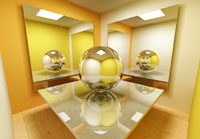Visualization
Global Illumination
 The richness of real world illumination is rarely captured in computer
graphics. However, many inroads have been made in recent years, and it
is now possible to render effects such as reflections, shadows,
indirect illumination, caustics, translucent materials and
participating media. Most of these effects have been made possible
through the use of Photon Mapping. Photon mapping was
originally invented at the department and it is still an area of
research.
However, many global illumination effects are still hard or impossible
to achieve in real-time rendering. For instance, soft shadows in
real-time systems is still a research topic. Hence, another important
focus of our research is to incorporate global illumination effects in
real-time rendering. Ultimately, the goal is to blur the distinction
between real-time rendering and off-line rendering.
Recent real-time projects include multiple specular reflections from
curved and planar reflectors, accelerated form factor computation for
radiosity, dynamic relighting, and soft shadows.
more
The richness of real world illumination is rarely captured in computer
graphics. However, many inroads have been made in recent years, and it
is now possible to render effects such as reflections, shadows,
indirect illumination, caustics, translucent materials and
participating media. Most of these effects have been made possible
through the use of Photon Mapping. Photon mapping was
originally invented at the department and it is still an area of
research.
However, many global illumination effects are still hard or impossible
to achieve in real-time rendering. For instance, soft shadows in
real-time systems is still a research topic. Hence, another important
focus of our research is to incorporate global illumination effects in
real-time rendering. Ultimately, the goal is to blur the distinction
between real-time rendering and off-line rendering.
Recent real-time projects include multiple specular reflections from
curved and planar reflectors, accelerated form factor computation for
radiosity, dynamic relighting, and soft shadows.
more
Contact:
Niels Jørgen Christensen,
Bent Dalgaard Larsen
Point Rendering
 Points were first proposed as a rendering primitive in the
mid-eighties but have received little interest till recently. However,
points have some benefits in conjunction with very large data
sets. When the average projected size of each triangle approaches a
pixel it begins to make sense to render points instead of triangles.
In connection with volume data, points also have the advantage that
they are faster to generate than triangles, thus points are well
suited for dynamic data. Finally, since points have not connectivity
(as opposed to triangles) there are no cache issues.
We have proposed techniques for point rendering of distance fields
and medical volume data. Currently, we are experimenting with point
rendering of dynamic volume data and LOD encompassing techniques for
point rendering of complex objects such as trees.
Points were first proposed as a rendering primitive in the
mid-eighties but have received little interest till recently. However,
points have some benefits in conjunction with very large data
sets. When the average projected size of each triangle approaches a
pixel it begins to make sense to render points instead of triangles.
In connection with volume data, points also have the advantage that
they are faster to generate than triangles, thus points are well
suited for dynamic data. Finally, since points have not connectivity
(as opposed to triangles) there are no cache issues.
We have proposed techniques for point rendering of distance fields
and medical volume data. Currently, we are experimenting with point
rendering of dynamic volume data and LOD encompassing techniques for
point rendering of complex objects such as trees.
Contact:
Andreas Baerentzen
Visualization and Manipulation of Medical Data
 Medical visualization on commodity hardware has become feasible thanks
to the enormous recent advances in the field of consumer graphics
cards. This project is a part of the collaborative 3D-Med project whose
goal is the development of a PC-based medical workstation for viewing
and measurement of volumetric, medical data such as CT or MR scans.
Our goals include fast texture based visualization of large volumes,
flexible and intuitive tools for adjusting transfer functions, likewise
intuitive tools for measurement, and finally tools for
manipulation of bone structures using shape modelling techniques.
Medical visualization on commodity hardware has become feasible thanks
to the enormous recent advances in the field of consumer graphics
cards. This project is a part of the collaborative 3D-Med project whose
goal is the development of a PC-based medical workstation for viewing
and measurement of volumetric, medical data such as CT or MR scans.
Our goals include fast texture based visualization of large volumes,
flexible and intuitive tools for adjusting transfer functions, likewise
intuitive tools for measurement, and finally tools for
manipulation of bone structures using shape modelling techniques.
Contact:
Bjarke Jakobsen